Skyward Sword Review by JuicieJ
Posted on December 30 2011 by Mases Hagopian
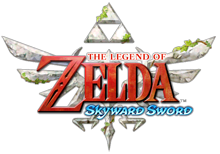 The Legend of Zelda: Skyward Sword is the latest addition to the legendary franchise and is widely considered to be one of its best games yet. Ever since its debut trailer at E3 2010, it’s been one of the most highly anticipated games in history. Fans were eager for a revolution in the series, and once the trailer was seen, many of us knew we had gotten what we asked for. During the wait, the hype for the game only grew and grew, and the hype surpassed that of the game’s predecessor, Twilight Princess. It took 5 years for Skyward Sword to release – the longest development period for any Zelda game – so it was only natural that it was so highly anticipated. But did Skyward Sword live up to its sky-high expectations? Read on to find out.
The Legend of Zelda: Skyward Sword is the latest addition to the legendary franchise and is widely considered to be one of its best games yet. Ever since its debut trailer at E3 2010, it’s been one of the most highly anticipated games in history. Fans were eager for a revolution in the series, and once the trailer was seen, many of us knew we had gotten what we asked for. During the wait, the hype for the game only grew and grew, and the hype surpassed that of the game’s predecessor, Twilight Princess. It took 5 years for Skyward Sword to release – the longest development period for any Zelda game – so it was only natural that it was so highly anticipated. But did Skyward Sword live up to its sky-high expectations? Read on to find out.
Gameplay
Nintendo said from the beginning that Skyward Sword will change the way Zelda is played, and that’s just what it has done. Through use of the Wii MotionPlus, players now have full control over Link’s actions. Link’s sword follows the motions of the Wiimote with unmatched precision, resulting in a huge combat evolution. Almost every combat situation now acts as a puzzle, meaning the player must read where enemies are defending and where they are vulnerable. This rings true for all enemies, even down to the simple Deku Babas, who must now be sliced either horizontally or vertically where their mouths are open. Other foes, such as Stalfos, will guard in ways that give you a reason to swing diagonally.
Combat isn’t the only thing that takes advantage of the Wii MotionPlus, however. Plenty of puzzles involving unique types of objects require use of the sword to advance forward, such as a circular pad on a door that must be hit in four specific directions to unlock. Other types of switches involve thrusting the sword into a gap and twisting the Wiimote to activate them. The Wii MotionPlus can occasionally get screwy, but it doesn’t happen often enough to be a major factor and can easily be fixed by performing a few vertical slashes or pointing the Wiimote at the screen.
 The items have also been adapted to the Wii MotionPlus. For instance, the Bow acts like a real bow & arrow; by holding C and pulling back on the Nunchuk, you can quickly charge powerful shots. The Whip cracks in the direction the player flicks the Wiimote. The Beetle changes direction while flying through the air as the player tilts the Wiimote in their hand. Even the Bug Net follows the Wiimote’s exact motions. All of this results in us having more control over Link’s arsenal than ever before. Twilight Princess on the Wii may have introduced motion controls to the Zelda series, but it pales tremendously in comparison to Skyward Sword and its MotionPlus.
The items have also been adapted to the Wii MotionPlus. For instance, the Bow acts like a real bow & arrow; by holding C and pulling back on the Nunchuk, you can quickly charge powerful shots. The Whip cracks in the direction the player flicks the Wiimote. The Beetle changes direction while flying through the air as the player tilts the Wiimote in their hand. Even the Bug Net follows the Wiimote’s exact motions. All of this results in us having more control over Link’s arsenal than ever before. Twilight Princess on the Wii may have introduced motion controls to the Zelda series, but it pales tremendously in comparison to Skyward Sword and its MotionPlus.
The innovative new item controls also allow for much more creative puzzle design, taking the dungeons to new heights. Some puzzles require the Beetle to grab a bomb and drop it onto an enemy or other obstacle to open a new path, while others have you use the Whip to swing across gaps. And this time around the items are used throughout the whole game. No item is picked up once and left behind after the dungeon it was found in, which is a huge step forward after many cases of this happening in Twilight Princess. The Whip is used significantly less than the other items, but it still finds its way into the game enough to not be considered a throw-away item. Items don’t have to be used exclusively to solve puzzles, though. They can be used in various creative ways outside of the dungeons, whether to defeat enemies in new ways or to just have some well-earned fun, both of which I took advantage of quite often. There are only eight items in Skyward Sword, but the fact that each one is used frequently and intuitively more than makes up for the small amount.
Skyward Sword also boasts a new upgrade system. Link can collect pieces of treasure dropped by enemies or find them in treasure chests and use them to upgrade his items and give them new abilities. For example, the Slingshot can be upgraded to the Scattershot, which gives it a spreadshot function, while the Beetle can be upgraded to fly farther and faster. Not all items have upgrades, but the ones that do give you great new ways to use them. The way these upgrades are utilized, however, depends on the player. You can use these items in a way that suits your own style, which allows for remarkable diversity between how different players go through the game. Item containers (Bomb Bags, Quivers, Seed Satchels) have also taken on this feature. Instead of winning a larger one via some sort of mini-game, players must purchase an extra container in order for Link to carry more of a specific item. In other words, extra bomb bags, quivers, and seed satchels must be purchased and upgraded in order to hold more of their respective contents. Each container can only be upgraded twice, but multiple extra containers can be purchased and upgraded as well, placing control of the amount of ammunition the player can carry in their hands.
Potions use this new upgrade feature too. After the player buys a potion, it can be upgraded using the various bugs caught throughout the game. A Heart Potion can be upgraded to restore all hearts rather than only eight, and can be upgraded again to have two uses. It’s a relatively small addition to the series, yet it has created a tremendous impact, making us earn the enhancements to our items by collecting the necessary spoils along the way, rather than having upgrades practically handed to us by winning a simple game. Even better, since there are only a maximum of eight slots designated for pouch items (item containers, shields, etc.), we’re allowed to customize the equipment that we bring on the adventure. For example, if you like to carry all the bottles to have potions ready like me, make sure to find all five bottles throughout the course of the game and catch bugs any time you get the chance if you plan to power-up potions. It’s quite obvious that the gameplay in Skyward Sword has dramatically changed the way Zelda is played. It’s fun, it’s innovative, and the motion controls are legitimately so great that fans will have trouble leaving them behind.
Content
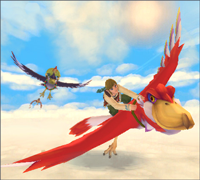 The controls aren’t the only thing that’s changed in Skyward Sword. The overworld has also been completely renovated. Instead of traveling across the terrain in the traditional dungeon-world-dungeon style of the large open fields of previous games, the land in-between the dungeons has become somewhat of a dungeon itself. Each area is littered with puzzles that fully test your abilities and utilize your inventory, which keeps the action constant throughout the game and turns the barren fields with only a few enemies into a thing of the past. Each province is also completely unique, ranging from lush forests to vast deserts. This allows for each province to have its own unique gimmicks and design concepts, such as hitching a ride across an fallen enemy’s shell across quicksand or dashing up a hill while avoiding obstacles.
The controls aren’t the only thing that’s changed in Skyward Sword. The overworld has also been completely renovated. Instead of traveling across the terrain in the traditional dungeon-world-dungeon style of the large open fields of previous games, the land in-between the dungeons has become somewhat of a dungeon itself. Each area is littered with puzzles that fully test your abilities and utilize your inventory, which keeps the action constant throughout the game and turns the barren fields with only a few enemies into a thing of the past. Each province is also completely unique, ranging from lush forests to vast deserts. This allows for each province to have its own unique gimmicks and design concepts, such as hitching a ride across an fallen enemy’s shell across quicksand or dashing up a hill while avoiding obstacles.
Just as each province is completely unique in terrain, there are multiple areas inside each province that are unique in design themselves. Later in the story you will return to each province and find areas that were previously closed off, so there are still fresh new experiences within previously visited provinces. Numerous save statues are all over each province as well, which have a secondary use as landing points that Link can automatically drop down to when returning to the land below, effectively functioning as the game’s warp system.
The mode of transportation used to travel from area to area has also changed. The three provinces, Faron, Eldin, and Lanayru, are not connected, making the sky the only means of getting from one province to the other. This may seem tedious at first, but Link’s Loftwing is very fast and agile, making the large sky seem smaller than it really is. The sky also has numerous little islands to land on and check out, reminiscent of the Great Sea in The Wind Waker. The islands aren’t typically that large, unlike in The Wind Waker, but it’s still worth it to drop in on them. Returning to Skyloft allows the player to restock their inventory and upgrade their items, to boot. Put that all together and The Sky becomes two things: quick and efficient. The travel in Skyward Sword is the perfect combination of action and relaxation, keeping the game enjoyable at all times.
All the action and adventure in Skyward Sword may make the game seem like it’s all business, but it has much more to offer than a straightforward storyline. There’s plenty of side-content for players who want to break off from the main plot. As stated earlier, there are many small islands in the sky that players can drop in on and check out. A few of these islands have minigames, such as Bamboo Island, where Link must see how many chops he can dish out on a large stalk of bamboo in order to get prizes. There’s even one island that’s basically a giant, colorful wheel known as Fun Fun Island, home to a minigame where Link must skydive through hoops and land on specific spaces on the spinning wheel in an attempt to win rupees.
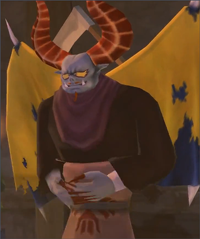 The largest quest out of all of them, though, is helping out a character by the name of Batreaux, a demon who just wants to be a human. In order to fulfill his wish, Link must collect Gratitude Crystals by solving people’s troubles in Skyloft and a handful of other islands. As the player continues to bring him Gratitude Crystals, Batreaux comes closer to becoming a human and rewards Link with prizes like larger wallets. These side-quests and minigames are the ideal way to take a break from the main quest and allow players to have some extra fun, even if the player only enjoys these quests alongside the main adventure. In fact, doing all the side-quests as you continue through adventure enhances the overall experience of the game more than you would imagine. My first playthrough of the game was mainly just going through the story with only a little time spent on side-content, and that alone was impressive enough. But when I completed the game 100% in a separate run through, I was completely blown away at how much more I enjoyed the game. It’s not an exaggeration when I say that Skyward Sword is the most expansive out of all the previous Zeldas, even more so than Majora’s Mask‘s. The game is so jam-packed with material that, combined with the 30-50 hour story, the game can easily last up to 100 hours depending on how you pace yourself while playing the game. All the content Skyward Sword has to offer is more than enough to keep players hooked the entire time and will always keep them coming back for more.
The largest quest out of all of them, though, is helping out a character by the name of Batreaux, a demon who just wants to be a human. In order to fulfill his wish, Link must collect Gratitude Crystals by solving people’s troubles in Skyloft and a handful of other islands. As the player continues to bring him Gratitude Crystals, Batreaux comes closer to becoming a human and rewards Link with prizes like larger wallets. These side-quests and minigames are the ideal way to take a break from the main quest and allow players to have some extra fun, even if the player only enjoys these quests alongside the main adventure. In fact, doing all the side-quests as you continue through adventure enhances the overall experience of the game more than you would imagine. My first playthrough of the game was mainly just going through the story with only a little time spent on side-content, and that alone was impressive enough. But when I completed the game 100% in a separate run through, I was completely blown away at how much more I enjoyed the game. It’s not an exaggeration when I say that Skyward Sword is the most expansive out of all the previous Zeldas, even more so than Majora’s Mask‘s. The game is so jam-packed with material that, combined with the 30-50 hour story, the game can easily last up to 100 hours depending on how you pace yourself while playing the game. All the content Skyward Sword has to offer is more than enough to keep players hooked the entire time and will always keep them coming back for more.
Story & Characters
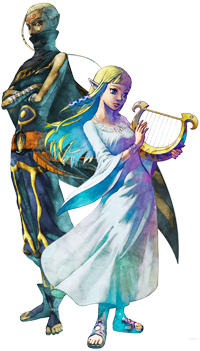 The Zelda franchise is not unaccustomed to prequels, and Skyward Sword is yet another in the series. The game is set before Ocarina of Time, taking the place of first game on the infamous Zelda timeline. It all starts out in a land above the clouds known as Skyloft, where Link and Zelda make their humble abode. The land was raised above the clouds countless generations before Link’s adventure began by a goddess in an attempt to keep the humans of the world safe from a tribe of demons invading the surface. Link is a knight in training, attending a school with his childhood friend Zelda. The people of Skyloft ride giant birds called Loftwings
The Zelda franchise is not unaccustomed to prequels, and Skyward Sword is yet another in the series. The game is set before Ocarina of Time, taking the place of first game on the infamous Zelda timeline. It all starts out in a land above the clouds known as Skyloft, where Link and Zelda make their humble abode. The land was raised above the clouds countless generations before Link’s adventure began by a goddess in an attempt to keep the humans of the world safe from a tribe of demons invading the surface. Link is a knight in training, attending a school with his childhood friend Zelda. The people of Skyloft ride giant birds called Loftwings
As usual, the adventure mainly consists of Link trying to find Zelda after she goes missing. While in pursuit, he constantly runs into an arrogant and flamboyant sorcerer known as Ghirahim, who is after Zelda for his own purpose: reviving his master. Link’s adventure eventually leads up to the creation of the Master Sword and sets up the events of Ocarina of Time. Along the way, his sidekick Fi, a blue feminine figure with robot-like traits, is constantly there to aid Link with any information he needs.
But just how good is Skyward Sword‘s story? I’d say exceptional.
The story of Skyward Sword is the most expansive and emotional one in franchise history. Throughout the adventure, there are constant twists and surprises that will keep players on the edge of their seats. Just about every chapter reveals new elements to the plot, ranging from huge revelations like discovering why everything has been happening, to minor foreshadowing. There are even numerous points where the goal of Link’s adventure changes, such as switching from trying to find Zelda to seeking out three Sacred Flames to transform Link’s sword into the Master Sword. Even though Link’s mission switches back to finding Zelda after finding the Flames – this time by use of the Master Sword to unlock her hiding place – more is lurking on the horizon that drastically alters Link’s motivation. There are also plenty of references to other games in the series, and while Skyward Sword makes very few canonical connections between games, it does explain a few things previously untouched. It’s truly a story for the ages, and one that long-time fans will enjoy immensely.
However, while the plot of Skyward Sword may be the best so far, it didn’t get that way on its own. The game’s characters are deeply involved with the story from the beginning, each with a significant amount of character development throughout the story, including Link himself. One character in particular is a classmate (and bully) of Link, known as Groose. I won’t reveal too much about what transpires with him, but I will say he goes through some significant changes in personality throughout the game. He’s doesn’t show up too many times, but does enough to be a factor in the story and actually plays a part in Link’s destiny. Other characters in Skyloft have an impressive amount of interaction with Link despite not playing a major role in the main story, namely the ones involved in the side-quests.
Some of the main characters aren’t all that standard for the Zelda series, though. Skyward Sword hosts a couple of characters that are fairly unique and could be considered to be very unique. One is Link’s companion, and the other is his adversary. Their names are Fi and Ghirahim. I mentioned these characters before, but I feel I need to go into more detail on them.
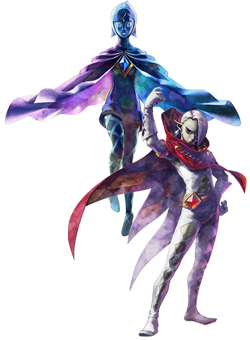 Fi is Link’s helper character in this game, which means she aids him during his adventure. She resides in the sword Link received just before he started his adventure and provides Link with the most detailed information on the surrounding areas and characters of any helper of the series. But that’s not the only way she’s different than any of the previous helper characters. Her design may be humanoid, but she’s anything but human-like. She acts very much like a robot, constantly spouting out percentages and calculations, speaking exclusively in terms of logic. As such, she views the adventure more as a mission to be carried out because she was ordered to instead of because it’s the right thing to do. Her emotionless persona is misleading though; she’s quite a lovable character. After all is said and done, she actually does have a small amount of character development, coming to appreciate Link and his selfless actions. She’s quite a lovable character despite the fact that she’s virtually emotionless.
Fi is Link’s helper character in this game, which means she aids him during his adventure. She resides in the sword Link received just before he started his adventure and provides Link with the most detailed information on the surrounding areas and characters of any helper of the series. But that’s not the only way she’s different than any of the previous helper characters. Her design may be humanoid, but she’s anything but human-like. She acts very much like a robot, constantly spouting out percentages and calculations, speaking exclusively in terms of logic. As such, she views the adventure more as a mission to be carried out because she was ordered to instead of because it’s the right thing to do. Her emotionless persona is misleading though; she’s quite a lovable character. After all is said and done, she actually does have a small amount of character development, coming to appreciate Link and his selfless actions. She’s quite a lovable character despite the fact that she’s virtually emotionless.
Then there’s Ghirahim. As mentioned before, Ghirahim is a flamboyant sorcerer who is quite the narcissist. He’s completely obsessed with himself, even to the point where he glorifies his own physique. Link runs into this bizarre character at the end of almost every dungeon, although they only fight directly a few times. He’s the main antagonist of the story, but he’s not in this for himself. Upon Link’s second meeting with him, he reveals that he needs Zelda to revive his master, and he hunts down Zelda without cease. Evil and cold-hearted as he is, though, he has a sense of dignity to him even though it isn’t due to any kind of morals. He’s a very diverse character, sometimes being cool and coy, while other times being absolutely ruthless. Normally these two opposite personalities would clash in a character, but with Ghirahim it’s pulled off perfectly. He’s one of the best characters (and villains) Zelda’s had yet, and his contribution to the story is half of what makes the game so entertaining. The main cast of characters in Skyward Sword are some of the best in the series, and they provide an immense sense of life and balance to the game, so immense that the story wouldn’t have had its charm without them.
Art Design
The graphical style in Skyward Sword is some of the best I’ve seen in gaming. Bringing back the colorful style of The Wind Waker and blending it with the more realistic textures of Twilight Princess, the graphics are vibrant and full of life, yet at the same time they have a more serious look to them. However, it’s not just the combined styles that make the game easy to look at. All objects up close look like 3D paintings with watercolor-like textures, while everything in the background looks like it’s been painted into the scenery with pastels. This unique look is a perfect workaround for the Wii’s limited hardware and provides Skyward Sword with Zelda’s most gorgeous and balanced art style yet. Graphics rarely make or break a game, but the art style of the graphics can make all the difference for the game’s tone, and the developers over at Nintendo clearly realize this. However, despite the fact that the great graphics debate of The Wind Waker had seemingly been overcome, controversy still arose among fans upon seeing the first trailer. There was less hate this time around, probably because people had already grown accustomed to The Wind Waker‘s look, but there was some complaining nonetheless. Thankfully, the graphics have gotten mostly well-deserved praise after Nintendo refined the demo graphics.
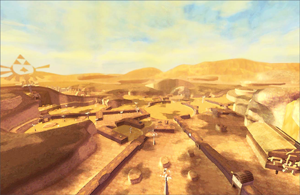 The visuals aren’t the only high point of the art, though. The music in Skyward Sword is equally impressive, although it’s not quite what we’re used to in a Zelda game. This time around, the musical tracks are much more grand and moving instead of being mostly simple, catchy tunes. Each track is designed to capture the emotion that each specific area or moment is supposed to invoke and instantly amplify it, allowing the players to feel the music instead of just listening to it. Some fans weren’t exactly pleased with the change, but I strongly believe that this has only benefited the game. The gorgeous tracks throughout the game are full of life and have brought a new vibe to their corresponding environments that allows the game to feel more believable than previous titles. The Wind Waker and Twilight Princess started this trend, but Skyward Sword has realized the full potential of what this kind of music can do for Zelda.
The visuals aren’t the only high point of the art, though. The music in Skyward Sword is equally impressive, although it’s not quite what we’re used to in a Zelda game. This time around, the musical tracks are much more grand and moving instead of being mostly simple, catchy tunes. Each track is designed to capture the emotion that each specific area or moment is supposed to invoke and instantly amplify it, allowing the players to feel the music instead of just listening to it. Some fans weren’t exactly pleased with the change, but I strongly believe that this has only benefited the game. The gorgeous tracks throughout the game are full of life and have brought a new vibe to their corresponding environments that allows the game to feel more believable than previous titles. The Wind Waker and Twilight Princess started this trend, but Skyward Sword has realized the full potential of what this kind of music can do for Zelda.
Skyward Sword also features live orchestration for the first time in the Zelda series, although not every track uses it. Large moments in the game, such as cutscenes or fighting a boss, often feature the orchestration, while the simpler moments have digital tracks. This was disappointing to the fans who wanted the game to be fully orchestrated, but I think it works out better this way. To me, the more relaxed moments actually feel more natural with digital tracks, as they have a more casual feel. Orchestration definitely fits the more action-packed moments, though, as real instruments capture epic presentation far better than digital music, so it was wise on Nintendo’s part to decide to use live orchestration for those parts of the game. Overall, the music in Skyward Sword is some of the best we’ve heard in gaming, and, aside from a few ear-splitters, like the songs from the game’s musical instrument (the harp), each one is easy to listen to, whether it’s laid-back or filled with intensity. All of the art in Skyward Sword is simply breathtaking and arguably the best we’ve seen in the series.
Verdict
To sum it all up, here are my scores for the major individual aspects of the game and the overall score.
Gameplay: 10
Content: 10
Story: 10
Art: 10
Final Score: 10/10
Skyward Sword is by far the best Zelda game to date – even better than the series’ crowned jewel, Ocarina of Time – and it could possibly be the greatest game ever made. The story is rich, the gameplay is smooth, and the action is almost non-stop. It’s truly a worthy addition to the Zelda series and a perfect way to cap off the year 2011 as well as the series’ 25th anniversary. The game has a few quirks, but there aren’t any major flaws present to drag the game down. Skyward Sword has single-handedly reminded the world why the Zelda series has retained the title of most iconic series in gaming history for the past 25 years, and if the series keeps up this pace, the sky is nowhere near the limit.



